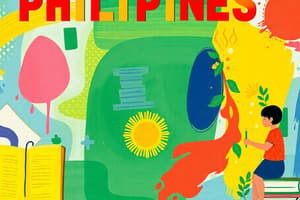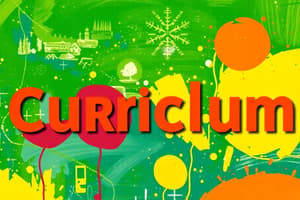Podcast
Questions and Answers
What is the primary aim of problem-centered designs in curriculum development?
What is the primary aim of problem-centered designs in curriculum development?
- To focus on individual and social problem-solving (correct)
- To integrate technology into every lesson
- To teach basic foundational knowledge only
- To standardize educational materials across disciplines
Which approach involves the integration of themes to support holistic education?
Which approach involves the integration of themes to support holistic education?
- Horizontal Organization
- Thematic Design (correct)
- Vertical Organization
- Problem Design
What does vertical organization in curriculum design emphasize?
What does vertical organization in curriculum design emphasize?
- Immediate application of learned skills
- Spiral progression of curriculum content (correct)
- Integration of community resources
- Focus on testing and evaluation methods
What is the goal of horizontal organization in curriculum design?
What is the goal of horizontal organization in curriculum design?
In the context of curriculum development, what is a key consideration for problem design?
In the context of curriculum development, what is a key consideration for problem design?
What does the Tested Curriculum primarily assess?
What does the Tested Curriculum primarily assess?
Which type of curriculum represents what society believes learners should know?
Which type of curriculum represents what society believes learners should know?
What is a characteristic of the Null or Censored Curriculum?
What is a characteristic of the Null or Censored Curriculum?
Which curriculum encompasses both formal and informal learning experiences?
Which curriculum encompasses both formal and informal learning experiences?
What does the Supported Curriculum reflect?
What does the Supported Curriculum reflect?
Which definition of curriculum emphasizes the specific competencies and standards students should achieve?
Which definition of curriculum emphasizes the specific competencies and standards students should achieve?
Which curriculum aspect concerns inputs that are often invisible in the formal teaching process?
Which curriculum aspect concerns inputs that are often invisible in the formal teaching process?
Which type of curriculum includes students' extracurricular activities and their overall learning experiences?
Which type of curriculum includes students' extracurricular activities and their overall learning experiences?
What type of curriculum refers to the actual implementation of the curriculum or what teachers in the school teach?
What type of curriculum refers to the actual implementation of the curriculum or what teachers in the school teach?
Which of the following areas is NOT one of the five important areas presented by Print regarding psychology in education?
Which of the following areas is NOT one of the five important areas presented by Print regarding psychology in education?
What does the Intended or Official Curriculum describe?
What does the Intended or Official Curriculum describe?
Which type of curriculum represents the most appropriate curriculum for learners as recommended by professional organizations?
Which type of curriculum represents the most appropriate curriculum for learners as recommended by professional organizations?
According to Sowell, the selection of curriculum content is important for what reason?
According to Sowell, the selection of curriculum content is important for what reason?
Which of the following best describes curriculum as a discipline?
Which of the following best describes curriculum as a discipline?
What aspect is NOT typically considered when studying the characteristics of students within curriculum development?
What aspect is NOT typically considered when studying the characteristics of students within curriculum development?
Which type of curriculum includes specific guidelines for evaluating student performance?
Which type of curriculum includes specific guidelines for evaluating student performance?
What are essential considerations for course planning in schools?
What are essential considerations for course planning in schools?
How should curriculum frameworks guide curriculum planning?
How should curriculum frameworks guide curriculum planning?
What is the role of CHED guidelines in higher education?
What is the role of CHED guidelines in higher education?
What must be reflected in lesson plans and course syllabi?
What must be reflected in lesson plans and course syllabi?
Why is it important for college curriculum planning to consider students' academic backgrounds?
Why is it important for college curriculum planning to consider students' academic backgrounds?
What is the impact of vocational course content prescribed by TESDA?
What is the impact of vocational course content prescribed by TESDA?
What does the hidden curriculum often reflect?
What does the hidden curriculum often reflect?
How can similarities in subject matter be utilized in curriculum planning?
How can similarities in subject matter be utilized in curriculum planning?
What is Hilda Taba's Grassroots Rational Model characterized by?
What is Hilda Taba's Grassroots Rational Model characterized by?
Which model emphasizes the importance of starting with goals and objectives in curriculum design?
Which model emphasizes the importance of starting with goals and objectives in curriculum design?
In which phase of Robert Diamond’s Systematic Design Model is curriculum production and implementation designed?
In which phase of Robert Diamond’s Systematic Design Model is curriculum production and implementation designed?
What is a primary characteristic of linear models of curriculum development?
What is a primary characteristic of linear models of curriculum development?
What aspect does Murray Print’s Model for Curriculum Development contribute to that is valuable?
What aspect does Murray Print’s Model for Curriculum Development contribute to that is valuable?
Which curriculum model is considered prescriptive and rational in its approach?
Which curriculum model is considered prescriptive and rational in its approach?
What is the focus of the cyclical models of curriculum development?
What is the focus of the cyclical models of curriculum development?
What is the primary drawback of the prescriptive model as highlighted in the content?
What is the primary drawback of the prescriptive model as highlighted in the content?
In terms of curriculum sources, which of the following is NOT included?
In terms of curriculum sources, which of the following is NOT included?
Which curriculum development model incorporates a team approach heavily relying on data?
Which curriculum development model incorporates a team approach heavily relying on data?
What is one of the key phases in Wiggins and McTighe’s Understanding by Design Model?
What is one of the key phases in Wiggins and McTighe’s Understanding by Design Model?
What does the rational linear model typically lack in its development process?
What does the rational linear model typically lack in its development process?
What is emphasized in the increasing abstraction step of curriculum development?
What is emphasized in the increasing abstraction step of curriculum development?
Which of the following models recognizes the roles of both students and teachers in curriculum development?
Which of the following models recognizes the roles of both students and teachers in curriculum development?
What is the primary purpose of situational analysis in curriculum development models?
What is the primary purpose of situational analysis in curriculum development models?
Flashcards are hidden until you start studying
Study Notes
Defining Curriculum
- Curriculum can be defined as a list of subjects, a set of learning experiences, or a collection of intended learning outcomes.
- Curriculum can also be viewed as planned learning experiences or a discipline with its own principles, theories, and practices.
- In terms of content, curriculum can be seen as a series of topics within a subject area.
Types of Curriculum
- Idea or Recommended Curriculum: Curriculum standards suggested by professional organizations, like those for sociology and anthropology.
- Intended, Official, or Written Curriculum: The official curriculum prescribed by the government or state, such as the K-12 Curriculum or CHED Curriculum for General Education.
- Implemented Curriculum: What teachers in schools actually teach, potentially diverging from the intended curriculum.
- Tested Curriculum: Assessed through teacher-made tests, curriculum-referenced tests, and standardized tests.
- Entitlement Curriculum: What society believes students should learn in order to become good members of society.
- Supported Curriculum: Influenced by available resources allocated for supporting or delivering the official curriculum.
- Null or Censored Curriculum: Topics or content that are purposefully not taught to students.
- Hidden Curriculum: Skills, knowledge, and attitudes students learn while interacting with others in school.
Curriculum Foundations
- Psychology: Provides important information for curriculum development:
- Educational objectives
- Student characteristics
- Learning processes
- Teaching methods
- Evaluation procedures
- Sociology and Anthropology: These disciplines highlight the importance of understanding contexts in which curriculum is developed, such as:
- Social and educational issues impacting implementation
- Learners' diverse needs, abilities, preferences, and socioeconomic backgrounds
- Students' academic backgrounds, especially for college students
Curriculum Development Models
-
Ralph Tyler's Rational Linear Model:
- Logical and systematic.
- Sequential pattern: Objectives - Content - Learning Experiences - Evaluation.
- Emphasizes defining educational purposes, experiences to achieve those purposes, the organization of learning experiences, and evaluating the attainment of objectives.
- Emphasizes curriculum sources like society, students, and subject matter.
- Emphasizes objectives based on philosophy and psychology of education.
-
Hilda Taba's Grassroots Rational Model:
- Similar to Tyler's model, but with more information input in each phase of curriculum development.
- Steps:
- Diagnosis of needs
- Formulation of objectives
- Selection of content
- Organization of content
- Selection of learning experiences
- Organization of learning experiences
- Determination of what to evaluate, and ways to evaluate.
-
Allan Glatthorn's Standards-Based Curriculum Development:
- Intended for diverse disciplines, from basic education to higher education.
- Contains three phases:
- Develop standards
- Develop benchmarks
- Develop final products
- Rational and descriptive, prioritizing the development of standards.
- Emphasizes using multiple sources and valuing teacher contributions in developing standards.
- Doesn't include situational analysis or needs analysis.
- Emphasis is on developing standards.
-
Wiggins and McTighe's Understanding by Design (UBD) Model:
- Also known as backward design.
- Emphasizes starting with goals and objectives in curriculum design.
- Engages students in deep understanding of important ideas and explores assessment designs.
- Focuses on enduring understanding or central ideas as the primary curriculum goal.
- Three stages:
- Stage 1: Identifying what is worth learning by examining current curriculum goals, standards, and expectations.
- Stage 2: Designing assessment evidence to validate the achievement of desired learning outcomes.
- Stage 3: Planning learning experiences, with teachers deciding on activities and materials.
-
Robert Diamond's Systematic Design Model:
- Prescriptive and rational.
- Two phases:
- Phase 1: Project Selection and Design: Determining objectives using curriculum sources and influences, relies heavily on data, and requires a team approach.
- Phase 2: Production, Implementation, and Evaluation for Each Unit: Designing for curriculum production and implementation, evaluation of instructional materials. Assumes the product (curriculum) is good as planned without review of decisions in Phase 1.
-
Murray Print's Model for Curriculum Development:
- Recognizes the roles of both students and teachers in curriculum development.
- Emphasizes situational analysis, which provides insight into the context in which curriculum is developed and gathers data from curriculum sources.
- Highlights the importance of contributing disciplines (philosophy, psychology, sociology) in selecting curriculum goals and objectives, content, learning experiences, and evaluation.
-
Wheeler's Curriculum Development Model:
- Cyclical.
- Elements of the curriculum are interconnected and dependent.
- Rational, where each phase is a logical development of the previous one.
-
Audrey Nicholls and Howard Nicholls Model for Curriculum Development:
- Cyclical.
- Elements of the curriculum are interconnected and dependent.
- Rational, where each phase is a logical development of the previous one.
-
Stark et al. Model:
- Focuses on situational analysis, gathering data from curriculum sources and influences, and understanding the context of development.
- Emphasizes contributing disciplines and their role in selecting curriculum goals and objectives.
- Weaknesses include:
- Curriculum workers in the Philippines are accustomed to linear models.
- Situational analysis is often tedious.
Key Points to Consider When Designing Curriculum
- Horizontal Organization (Scope and Horizontal Integration): Focuses on arranging curriculum components at a given point in time. Establishes relationships and integration across subject areas.
- Vertical Organization (Spiral Progression): Distributing curriculum content across grade levels, enabling students to build upon prerequisite knowledge and master content over time.
- Whole-to-Part Learning: Deductive approach starting with the big picture and gradually moving to specific concepts and skills.
- Increasing Abstraction: Arranging content based on concepts or skills relevant to students' personal experiences.
Studying That Suits You
Use AI to generate personalized quizzes and flashcards to suit your learning preferences.




